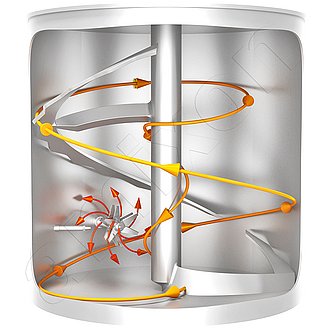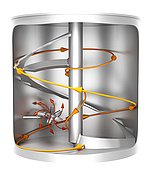Dispersing and Deagglomerating of Powder
What is a dispersion?
In the context of powder mixing. A dispersion is a heterogeneous mixture of at least two substances that do not or hardly dissolve in each other or combine chemically. To achieve ideal mixing qualities, heterogeneous, disperse substances must first be deagglomerated. Only then can a homogeneous mixture - the so-called continuous phase - be created. The process of dispersive mixing is used for this purpose. A heap of dry bulk materials is a dispersion consisting of ambient air and the solid particles. The amount of air in the pile can be determined. It is a measure of porosity.
Dispersion: Definition and importance of the process in mixing technology
A homogeneous dispersion is a mixture of substances in which the porosity is homogeneously distributed. Agglomerates hinder the mixing process. Agglomerates are agglomerations of powder particles. The process of deagglomeration separates the particles. The boundary surfaces of all particles are then available for chemical processes. Agglomerates are broken up using an adapted energy input. They can then be dispersed micro-fine in another material. amixon® has developed mixing systems for this purpose, which reliably deagglomerate mixed materials with vortex, friction and impact forces and ensure ideal mixtures at all times.
The types of dispersion: dry dispersion and wet dispersion
If the powder leads in a dry state, this is called dry dispersion. If liquid substances are added, this is wet dispersion. If each individual particle is surrounded by the liquid phase, a suspension is present.
In principle, fine particle collectives are easier to deagglomerate in liquids because the mutual adhesive forces are lower. In wet dispersion, bulk material is placed either as a dry powder or as a suspension in a closed liquid circuit and subjected to a high energy input. This type of dispersion is used when the product tends to form strong agglomeration and is very difficult to disperse.
Successful dry dispersion with amixon® mixing technology
amixon® supplies innovative process equipment for the purpose of dispersing. In doing so, amixon® pursues the goal of gentle mixing. The primary  particles should remain intact. No abrasion and no dust should be generated.
particles should remain intact. No abrasion and no dust should be generated.
Highshear blades
To break up hard agglomerates, highshear blades protrude laterally into the mixing vessel and operate at speeds of up to 3,000 rpm. They de-agglomerate, de-clump and enlarge the boundary surfaces. With highshear blades, liquid distribution takes place directly through vortex, friction and impact effects with increased energy input. The cutting rotors support the finest distribution of liquid binders and high-viscosity liquid admixtures. They are injected by means of a drawbar lance below the filling level directly into the effective area of the whirler.
Dissolvers work in batches
Dissolvers can produce suspensions or solutions when they disperse powders in a liquid phase. Dissolvers are used for dispersing easily wettable materials. A toothed agitator disc rotates at high peripheral speed below the liquid level. The teeth grind the agglomerates into small primary particles. The faster the disc rotates, the higher the energy input. Due to its high peripheral speed, a dissolver is suitable for low to medium viscosity materials.
HighShear mixers operate continuously
The process described above can also take place continuously. A high-speed rotating grinding tool conveys the liquid in a circle. The grinding tool is similar to the rotor of a centrifugal pump. This creates a vacuum. The powder is sucked into the liquid. The production of suspensions usually works well if the liquid does not foam.
